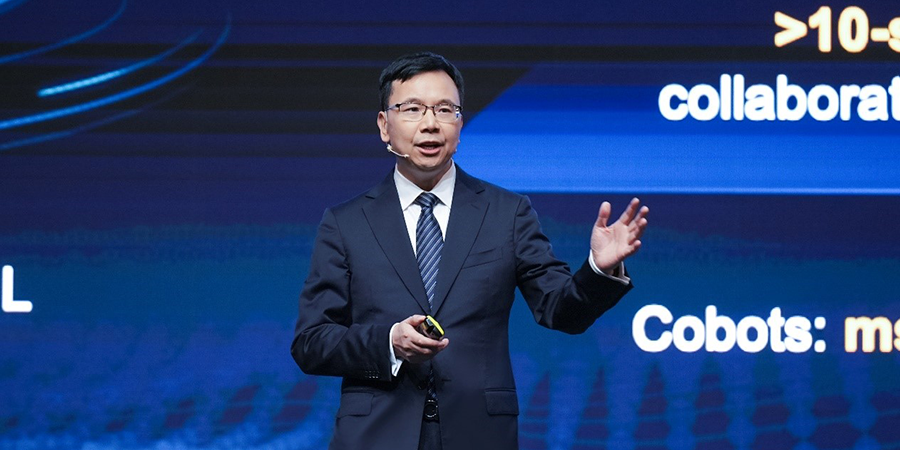During a keynote speech at the Global MBB Forum 2024, Yang Chaobin, Huawei's Board Member and President of ICT Products and Solutions, said, "The upcoming mobile AI era will create huge opportunities for the mobile industry and profoundly shape the decade to come. Evolving 5.5G technology will be the key to unleashing the potential of mobile AI. Huawei looks forward to collaborating with all industry partners to evolve 5.5G and solidify the foundation of the mobile AI era. Together, we can help society and industry go intelligent."
The Era of Mobile AI: A Two-Fold Trend
According to Chaobin, two trends have emerged due to the rapid evolution of 5.5G and AI technologies, which are set to reshape the industry and usher in an "era of mobile AI."
He described the first trend as "Mobile going AI," where mobile internet services are being reshaped by new business models and services powered by AI. The second trend is "AI going Mobile," where enormous business opportunities are being unlocked by new mobile services like smart vehicles and robots. These developments, he claims, are creating new momentum and opportunities for both society and the mobile industry.
Huawei says these trends will influence the ICT industry in three specific ways. Firstly, AI agents for individuals will reshape mobile internet services such that everyone has a personal smart assistant, meaning AI agent networks will need to support real-time services. Secondly, smart driving will transform mobility by turning vehicles into flexible and smart spaces, thus, smart vehicle networks will need to deliver high uplink speeds. Thirdly, generalized embodied intelligence will make its way into different scenarios to unlock new productivity and a 10-billion-unit AI-robot market, consequently, future robotics networks will require comprehensively higher capabilities.
5.5G Penetrates Five Key Areas
Chaobin explained that 5.5G networks can support the varied connections, experiences, and services required to meet the demands of AI agents, smart vehicles, and embodied intelligence. These networks drive innovation and development across five key areas:
Firstly, 5.5G can address diversified experience requirements by providing high-bandwidth networks. As users increasingly require diversified experiences, sub-100 GHz bands can be integrated on-demand to flexibly deliver the network capabilities needed for superior multi-factor experiences. "0-Bit, 0-Watt" technology can also be used to enable superior energy efficiency.
Secondly, 5.5G can be used to optimize device TCO as it enables a single network to integrate all-scenario IoT connections. RedCap and passive IoT technologies are lowering the cost of IoT, and 5.5G is needed to maximize the number of connections that can be simultaneously supported. Upgraded network capabilities are also needed to empower devices and bring IoT connections everywhere.
Thirdly, 5.5G can provide unified portals that support differentiated experience assurance and monetization, something that carriers will need to cope with given the increasingly diverse service requirements. 5.5G core networks have the capacity to deliver the user-, service-, and network-awareness capabilities needed for differentiated experience-based monetization.
Fourthly, 5.5G can provide a unified service portal that makes mobile AI more affordable and supports diversified smart services. Carriers will need the native AI service portal provided by 5.5G core networks to share network capabilities with third parties, enabling smart services to be accessible on more affordable mobile devices.
Fifthly, 5.5G can use the Telecom Foundation Model to enable high-level network autonomy and realize the concept of "0 Touch, 0 Wait, 0 Fault." The Telecom Foundation Model equips high-level, autonomous networks with full-stack intelligence by providing two types of applications—copilots and agents—and three types of digital experts. This marks the beginning of a new trend in terms of network operations.
The 15th Global Mobile Broadband Forum, with the tagline "5.5G Leads Mobile AI Era," ran from October 30 to 31 in Istanbul, Türkiye. It was hosted by Huawei with the support of the GSMA and GTI. Together with operators, vertical industry leaders, and ecosystem partners, the industry's latest advancements were shared, and new opportunities were explored. Industry stakeholders discussed strategies for achieving business success with 5.5G in the Mobile AI era, focusing on building upon the success of 5G to reach even greater milestones with 5.5G.
Explore Huawei’s 5.5G Journey:
Huawei Highlights Open Gateway's Crucial Role in Shaping 5G-A Networks at MWC Shanghai
du and Huawei Collaborate to Advance 5.5G Journey
Huawei and China Unicom Beijing Pilot Test 5.5G Network





